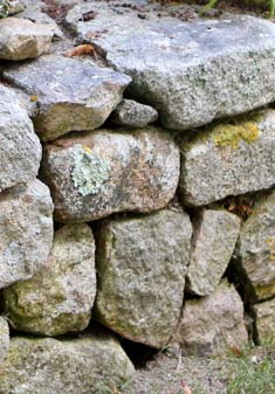In winter, architectural design and its hard shapes, of stone, or concrete, are the things that capture one’s eye. Evergreens surround them with the only color of winter. But when everything else is dead or sleeping, it is those hard shapes that define the design.
They are called “Hardscape.” They are forms, individual things, like walls or walks or paved areas, or statuary. They survive the ice and snow of winter. They define the architectural design, which is basic to any good garden, park or open space.
Hardscape can be simple, like rustic stone walls. Old roads, pastures, farm areas, even parks are defined by these walls. It’s always interesting to discover an old farm wall in the middle of what is now a second generation forest.
These old authentic walls are quite fascinating. When the farmers cleared the land, they used the large rocks to build double sided walls which left a space in the middle. This they filled with the small stones. Even more interesting is that they tipped the large outer rocks so that their centers were lower than their outside edges. This allowed the walls to expand with frozen water, ice and snow, but then fall back into place (by gravity) as it melted.
A perfect 90 degree stone wall will expand outward and not fall back into place unless it is built with very special skill or the rocks are set in concrete. Most 90 degree walls eventually crack or the top falls off. The old farmers knew better.
Hardscape is made of many materials. Brick. Pavers, Bluestone. Slate. Concrete. Concrete blocks that look like all kinds of stone, and are much easier to build with than field stone. Hardscape is very fashionable these days because it is permanent and easy maintenance.
Landscape companies like it because it is expensive, and so more profitable than just an all green landscape. Well done stone walls and paving define a well designed garden.
Also necessary are visual points of interest. These may be interesting rocks (think Japanese gardens). Or they may be statues and artifacts (think Versailles). Of course they may be pink flamingos, if that is your preference. Mine is flower fairies.
It started when my first grandchild was 3 and afraid of the night. Thus the flower fairies were born. Flower fairies live underground with their grandmother. Each night at Eventide, when the church bells ring, they come out and dance. In summer, where their feet touch the ground, flowers open. After dancing, they go and sit on the bed of a scared child, to protect it with a big, long balloon.
But you can only see them with your eyes closed! It’s a grandmother story. Over the years a number of fairies were bought. Concrete perhaps, but once a fairy, always a fairy. Especially naughty fairy Mary.
My grandchildren are now all grown, but the little fairies are true. Awaiting the touch of a little hand, the smile of a little face. They are on the paths, at the door, protecting the birdfeeder. With happy memories. They have become part of my Hardscape for winter.
Ruth S. Foster is a landscape consultant and arborist. More gardening information can be found on her website, www.mothersgarden.net.




























